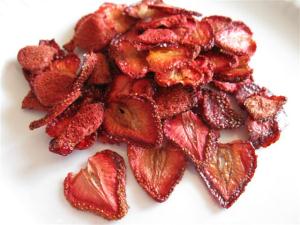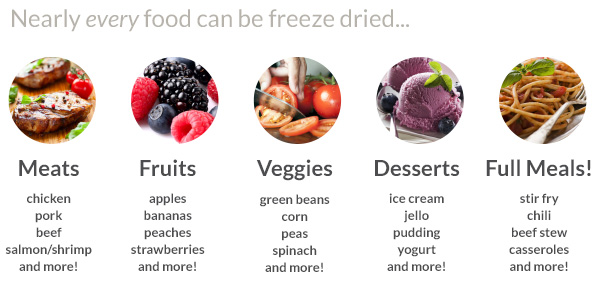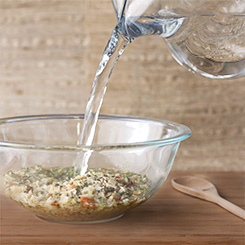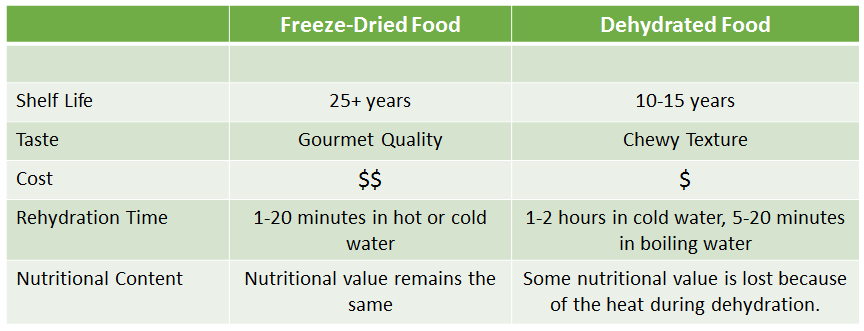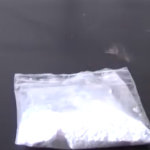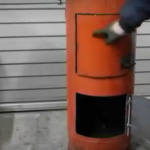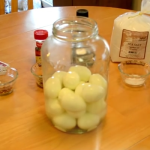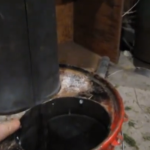Both storage methods rely on removing water from foods in order to preserve them for long periods of time. However, there are fundamental differences when it comes to the process, taste, nutritional content and potential shelf life. The good news is that both options are beneficial from a preparedness standpoint, and it generally boils down to individual preference, cost and the availability of food choices when making storage decisions.
Water Removal
Dehydration, if done properly can remove up to 95% of water from foods. Freeze drying foods can remove more than 98%. While this doesn’t sound like a big difference, those extra percentage points gained from freeze drying can significantly lengthen the shelf life of foods.
Freeze drying is a newer method that stemmed from finding ways to make foods more light-weight, easier to package, store and re-hydrate during WWII. It involves flash freezing and then flash heating foods in a vacuum chamber to remove all of the water before it has a chance to evaporate normally. Dehydration has been a method that’s been around for ages as a way to slowly warm food at low temperatures to the point where water evaporates from the product.
Nutrient Retention
The general consensus is that freeze dried foods retain more vitamins and minerals because the process occurs so quickly that they get “locked” into place. However, this method can reduce the amount of vitamin C. Dehydration is considered to weaken the potency of some nutrients, but it does not eliminate all of them together. In both cases, vitamins can be added during the re-hydration process in order to boost nutrient levels.
Re-hydration
Foods that have been freeze dried just need some hot water and can return to their semi-original state within a few minutes. This is possible because the foods retain much of their original structure during the flash-freezing process. The empty spaces within them that exist from water removal will be filled once again from re-hydration. Dehydrated foods take longer to re-hydrate because they tend to flatten and condense as water is removed. The consistency of re-hydrated foods from this process ranges from semi-original to rubbery, depending on the product. Both methods do not generally influence the taste.
Practicality and Food Choices
Freeze-drying foods requires expensive equipment and is usually processed at commercial facilities. Dehydrating foods can be done through a variety of methods at home or out in the field. One example is the making of jerky. All you really need is a rack and some direct sunlight, a low-temperature oven, heat lamp or commercial dehydrator. Dehydrating food is also far less expensive than freeze-drying. Consequently, you can choose the items that you want to dehydrate as opposed to being limited by what is available through commercial producers and vendors.
Freeze dried foods require less energy to re-hydrate because they are designed to quickly absorb water. This can make a difference in situations where time is of the essence and resources are limited. They also tend to be prepackaged into specific portions and ready for immediate consumption.
Finally, remember that you will need to include additives such as salt or sugar during the dehydration process in order to make it work properly. Freeze-dried foods tend to remain in their natural state, and this should be a consideration if you are storing items for people with specific dietary requirements.
From a planning and preparedness standpoint, it is up to you to decide which option will work best. Just remember that you don’t have to choose one over the other. Freeze-dried foods are ideal for bug out bags or situations where space, resources and time are important. Dehydrated foods are ideal for home-storage when you know they can be consumed before their shelf-life expires. Mixing things up a little bit will give you more choices and flexibility when it comes to preparing.



